Menus
- What can the Nippon bikes do today??
- They all get the same tires
- Honda Fireblade SC 57
- Kawasaki ZX-10R from 2004
- Suzuki GSX-R 1000 K5
- Yamaha YZF-R1 RN 12
- Performance Honda Fireblade
- Performance Yamaha YZF-R1
- Performance Kawasaki ZX-10R
- Performance Suzuki GSX-R 1000
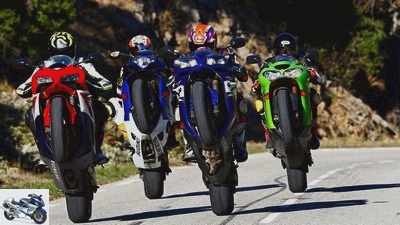
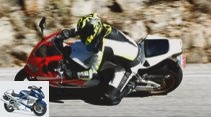
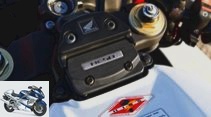
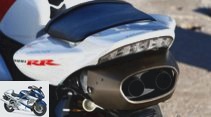
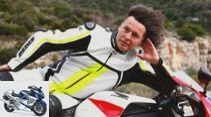
43 photos
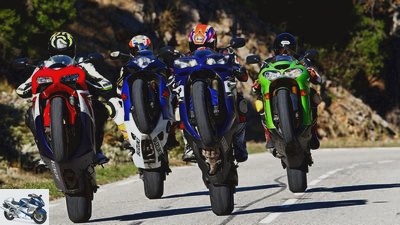
1/43
New and old. 14.33 years later. Japanese superbikes in comparison.
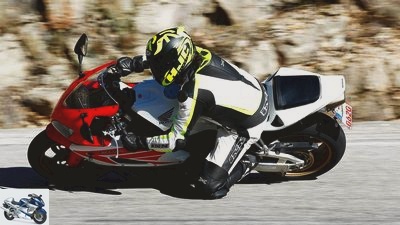
2/43
Honda Fireblade SC 57 (2004).
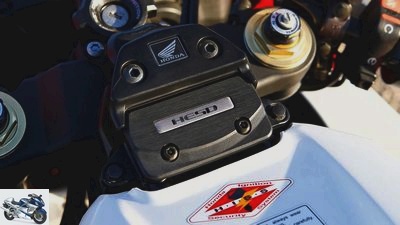
3/43
The electronically controlled steering damper HESD made its debut in the SC 57 – it works perfectly.

4/43
At that time, the CBR 1000 RR still had its exhaust under the rear. In the later models, the system moved back down or to the side for the purpose of mass centralization.
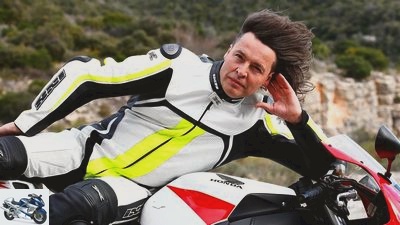
5/43
“The Blade does what I want!” Peter Klein, PS auxiliary racer, intentional Winnetou double and former series sport racing driver, is pleased with the sociability of the Honda.
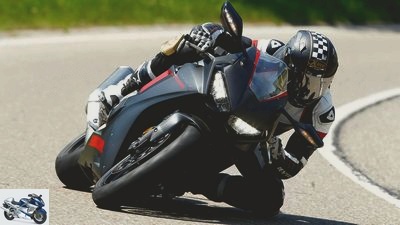
6/43
Honda Fireblade SC 77 (2017).
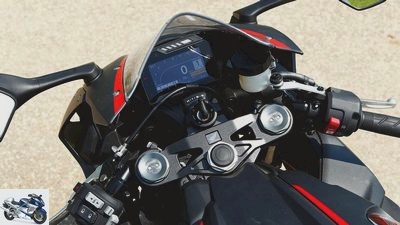
7/43
This is what it looks like in the cockpit of the current Fireblade. The electronic steering damper is no longer visible and is integrated into the chassis.

8/43
The current blade leads the exhaust sideways. She sounds angry for a Euro 4 motorcycle.
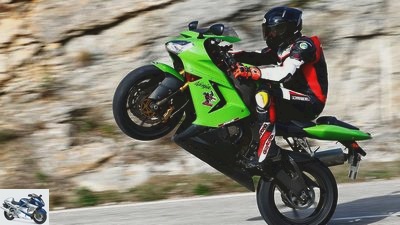
9/43
Kawasaki ZX-10R (2004).

10/43
The ZX-10R from 2004 has a laterally arranged exhaust pipe and emits hoarse growling tones from it – sounds great!
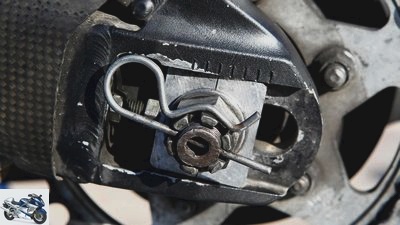
11/43
Legend has it that Kawasaki accidentally bought a few million of these locking pins for the rear axle. Every kawa has been equipped with it ever since.
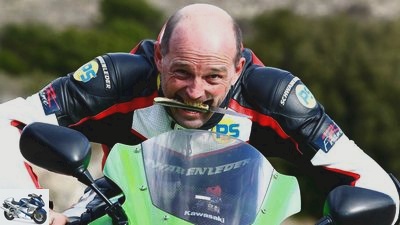
12/43
PS legend and indefatigable Angaser Volkmar “Jacko” Jacob: “The softened successors do not come close to the rough charm and the goosebumps feeling of the ZX-10R from 2004. Raw, pure and animal – a real attacker moped! “
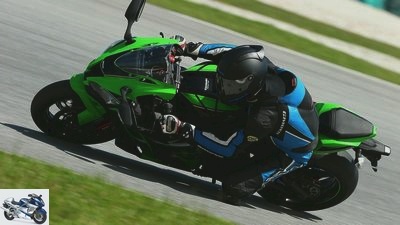
13/43
Kawasaki ZX-10R (2017).
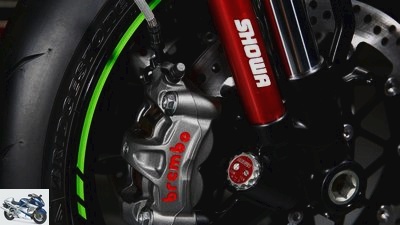
14/43
For the 2017 model update, the Zehner received top monoblock brakes and a fine high-end Showa fork as standard.
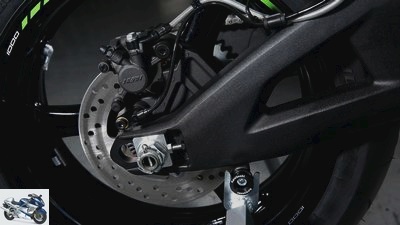
15/43
The proof for the thesis put forward in the caption 02 on page 24: The legend seems to be true!
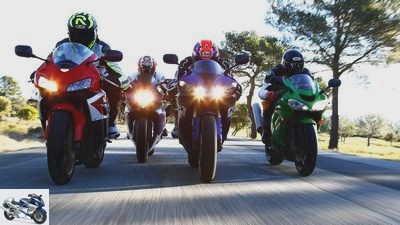
16/43
“Always have the latest material with you. Puff cake – these sweethearts have been on it for 1.5 decades “.
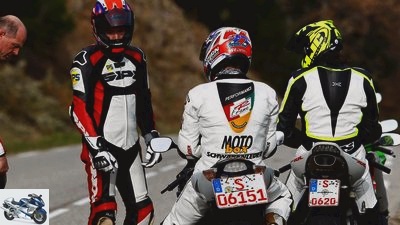
17/43
Short stopover for a chat: “Do you think a 200-horsepower super sports car would be faster here than us?” A deeply convinced answer: “No … can’t be!”

18/43
Suzuki GSX-R 1000 K5 (2005).
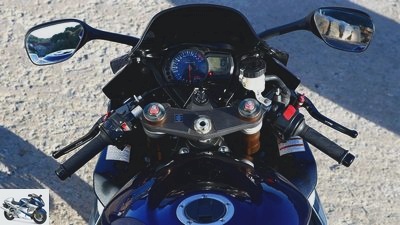
19/43
The K5 has a narrow, sharply formed front fairing. A gear display and indicators integrated into the mirrors were not yet a matter of course in 2005.
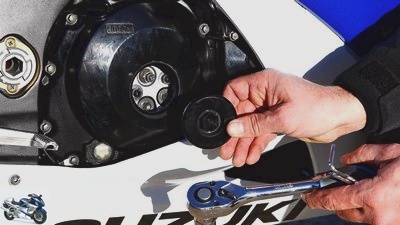
20/43
From and for racing: The Gixxer has an adjustable anti-hopping clutch.
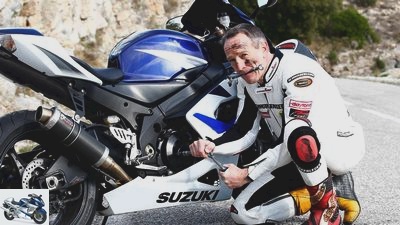
21/43
Steini in his world. He knows every screw on the GSX-R 1000 K5 (he is currently fiddling with the adjustable anti-hopping clutch). The only thing he hasn’t shown us is his Suzuki tattoo.
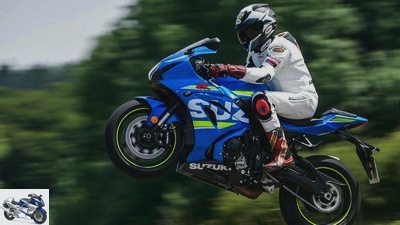
22/43
Suzuki GSX-R 1000 L7 (2017).
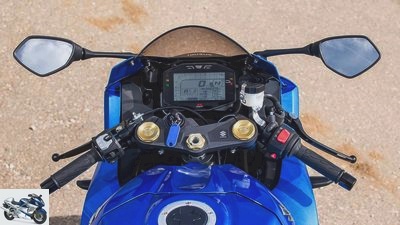
23/43
In terms of design, the GSX-R has remained pretty true to itself over the years. The round tachometer instrument is history, however, there is now a multi-function instrument.
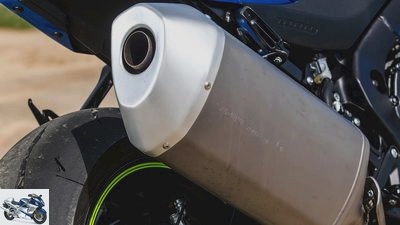
24/43
The original exhaust of the K5 was a massive beating – and the L7 continues this “tradition”.
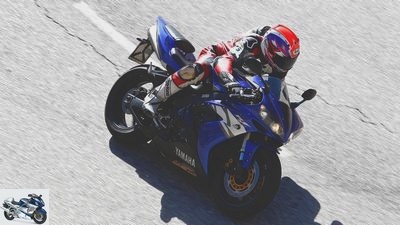
25/43
Yamaha YZF-R1 RN 12 (2004).
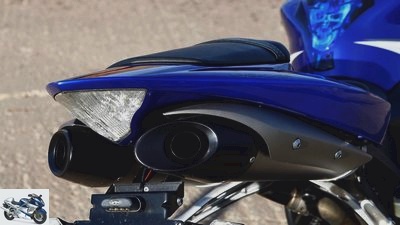
26/43
European-looking design and a cheeky sound: the RN 12 knew how to set accents, and not just because of the chic exhaust system.
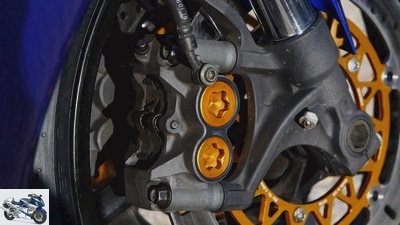
27/43
A clever solution: The brake calipers of the RN 12 are made from one piece. The golden anodized caps are only required for installation or for maintenance work.
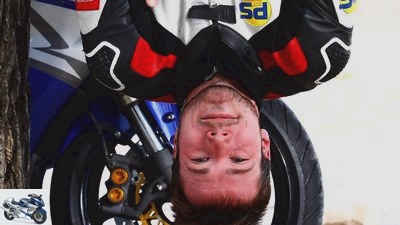
28/43
PS editor Tobi had to turn on his head to finally be able to ride the 2004 superbikes. For the R1 it can definitely warm up. And for the blade. And for…
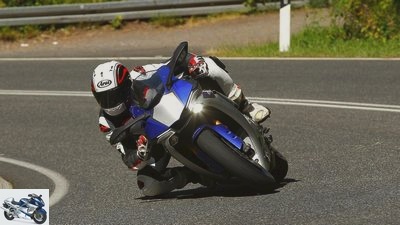
29/43
Yamaha YZF-R1 RN 32 (2015).
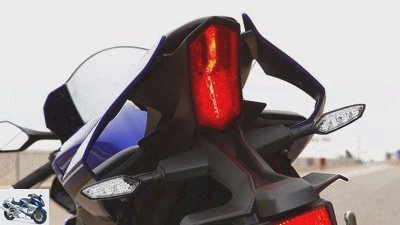
30/43
Streamlined: The current generation R1 follows a new, MotoGP-inspired design language.
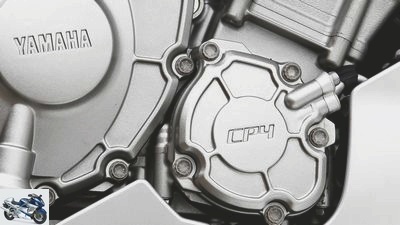
31/43
It used to be a “screamer”, but since the RN 22, Yamaha has relied on an irregular firing order. The in-line four sounds almost like a V4 engine.
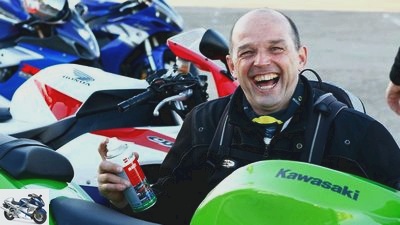
32/43
PS tester Jacko drove B license races in the super sports class ages ago. And on Kawa. The ZX-10R from 2004 still gives him pleasure today, even when cleaning!
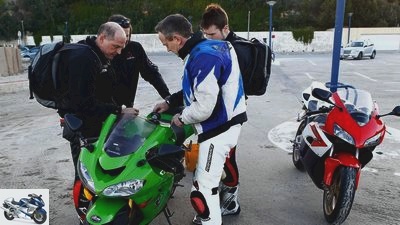
33/43
The rental Kawa had a passenger grab handle screwed to the fuel filler cap – it has to go. But the stuntgirl Mai Lin stickers on the side are allowed to stay.
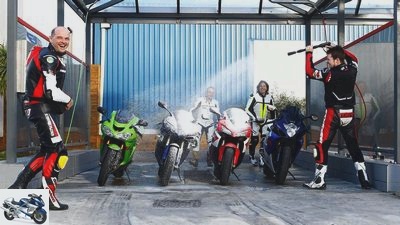
34/43
No, they didn’t burn. But after a foam treatment, the ladies of the old guard almost sparkle a bit like in 2018. But only almost.
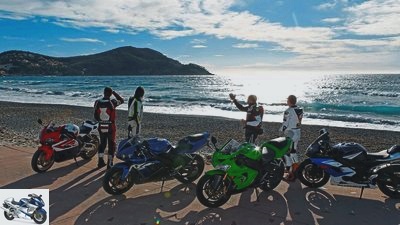
35/43
“Aviators, give me my regards to the sun! We’ll continue to do a lap on the ground missiles “
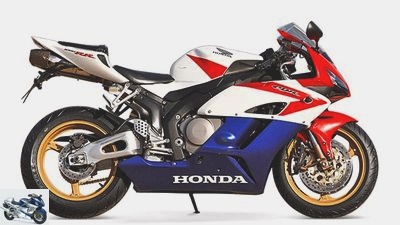
36/43
Honda Fireblade SC 57 (2004). Max. Power: 112.6 kW (153 PS) at 271 km / h.
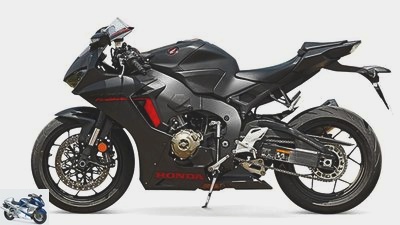
37/43
Honda Fireblade SC 77 (2017): Max. Power: 128.0 kW (174 PS) at 271 km / h.

38/43
Yamaha YZF-R1 RN 12 (2004): Max. Power: 115 kW (156 PS) at 278 km / h.
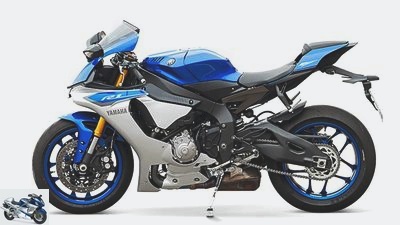
39/43
Yamaha YZF-R1 RN 32 (2015): Max. Power: 139 kW (189 PS) at 268 km / h.
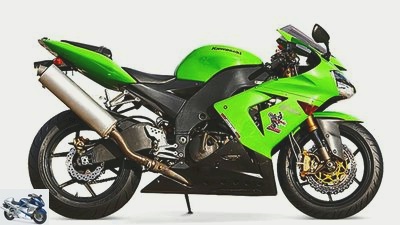
40/43
Kawasaki ZX-10R (2004): Max. Power: 116.9 kW (159 PS) at 257 km / h.
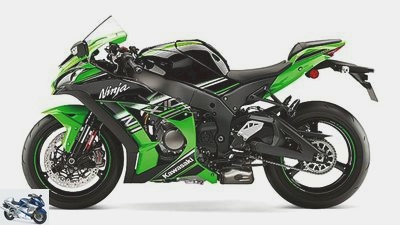
41/43
Kawasaki ZX-10R (2017): Max. Power: 134.5 kW (183 PS) at 280 km / h.
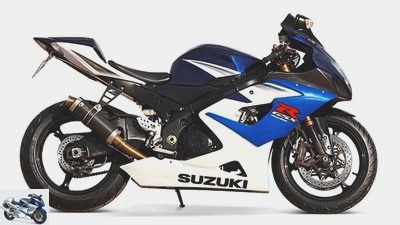
42/43
Suzuki GSX-R 1000 K5 (2005): Max. Power: 119.9 kW (163 PS) at 265 km / h.
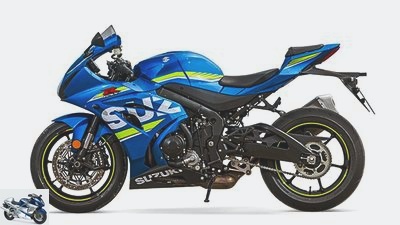
43/43
Suzuki GSX-R 1000 L7 (2017): Max. Power: 131.6 kW (179 PS) at 259 km / h.
2004 and 2005 superbikes tested
What can the Nippon bikes do today??
Content of
In 2018 we will be gathering the illustrious Japanese superbikes from 2004/2005 again for a test to clarify the following question: Will the superstars of yesterday still live up to their reputation as hot shells today?
Honda Fireblade SC 57, Kawasaki ZX-10R, Suzuki GSX-R 1000 K5 and Yamaha YZF-R1 RN 12 – what about the legendary Japanese superbikes of 2004 and 2005? Can the material still raise hair on the back of the neck today? Maybe already! Because when we stand at the pass with the Nippon distillers in the south of France and I post a photo on our Facebook page of Blade and Co., the response is huge: “Ah, finally a real PS topic again,” is a comment few minutes later. Also read: “Caution, no electronics. You need feeling in your right hand! ”Certainly just a well-intentioned warning. Another writes short and sweet: “2004 ZX-10R: World power.” So, so.
Buy complete article
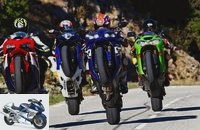
2004 and 2005 superbikes tested
What can the Nippon bikes do today??
No trace of Ducati and BMW
It wasn’t particularly difficult to get the Japanese ladies together for a rendezvous. As used machines, the four cavort on the portals of relevant Internet exchanges in large numbers. All of them were top sellers and sold really well, because the Japanese with their super sports cars held the monopoly on the market at that time. There wasn’t a lot of competition. In 2004, Ducati still built the 749, 998 (as Matrix and Final Edition) and 999 models. No sign of a Panigale, let alone a V4 engine.
An even more blatant example: BMW. At that time, Bayerische Motoren Werke still thought super athletes were stupid. The most dynamic iron in the range was the K 1200 RS (curb weight 285 kilos) or the R 1100 S with a boxer engine. It wasn’t until 2009 that BMW brought the S 1000 RR with 200 hp and electronics to the fore. All at once it took the butter off the Japanese machines in selective comparative tests – and nothing came out of Nippon. Honda, Kawasaki, Suzuki and Yamaha fell into a long slumber of development.
They all get the same tires
But back to the days of Japanese glory. In order to ensure that our “retro superbikes” functioned perfectly here and now, each of the four received a mechanical check and a set of fresh Metzeler M7 RRs before they left. The Metzeler cuts a fine figure on country roads because it has a positive effect on handling. In addition, the tire works well in a wide temperature window, and the rubbers build up enough grip for proper lean angles even below ten degrees Celsius. Exactly what we need here in France!
Honda Fireblade SC 57
As I sneak around the Fireblade from the “pre-200 hp era”, I notice two things: First of all, there is a component above the fork bridge with the label “HESD”. The SC 57 was the first blade to be equipped with the electronically controlled steering damper (Honda Electronic Steering Damper) – it works excellently. And secondly, this model was the only Fireblade to date to have a rear silencer running under the seat. Still looks sharp today and sounds really angry! At that time, Euro 2 gave sound and exhaust emissions a completely different scope. In the case of the successors, the concept with the exhaust system installed above was rejected again. In favor of improved handling through mass centralization, the exhaust later moved back down or to the side. Without direct comparison options with the current model, none of us testers would come up with the idea of accusing the SC 57 of sluggish driving behavior. The 2004 CBR 1000 RR probably won’t turn corners as quickly and effortlessly as a current Blade, but it still doesn’t do a bad job. It is noticeably stable and hits the lines precisely.
Every Fireblade has the reputation of being a very rewarding and easy-to-drive sports motorcycle – the SC 57 is no exception. A blade always looks like it is made of one piece, drives harmoniously and well-balanced. Roasting up the pass with the old Fireblade is done with a great sense of security and is really good fun! Your ABS-free brake grips cleanly, even by today’s standards, and is easy to dose.
Honda Fireblade SC 57 (2004).
What else can she do? The engine in particular provides a pleasant surprise. The four-cylinder pushes brilliantly in the mid-rev range! Superbikes of the current model years have a different conceptual approach. With the racetrack in focus, the engines are generally designed more for peak performance at high speeds in order to mobilize 200 hp or more. When asked whether this is absolutely necessary on the country road, we answer “no”. Over 170 fully squeezed horsepower is enough power for public roads. No matter what the regulars tell.
But we miss one or the other achievement of modernity, for example in response. Where current generations of CBRs gently accelerate thanks to electronically controlled throttle valves, the SC 57 affords one or the other jerk. The ergonomics reveal further differences. In general, Fireblades offer a generous amount of space. The ergonomic triangle consisting of handlebars, seat and footrests simply fits. But the 2004 model has a noticeably wide tank and in this and other areas, such as the rear, side and front panels, looks significantly more massive than a sharper modern blade.
Anyone interested in buying a used SC 57 can look forward to solid technology. During its construction there was only one official recall due to a possible fuel leak on the tank ventilation pipe. As far as transmission, clutch and brake are concerned, our rental machine is in a really fresh (maintenance) condition after a little more than 20,000 kilometers of unwinding, according to the speedometer.
Besides PS veteran Volkmar “Jacko” Jacob, Peter Klein and Achim Steinmacher are also part of this special test mission. All of them have a thick case number of racing in their vita and are very familiar with the old ladies. Their unanimous verdict on the Blade: “A flawless vest – it just drives. Definitely a Honda! “
Kawasaki ZX-10R from 2004
Color change. From the Honda it’s on to the bright green Kawasaki ZX-10R. When the Kawa entered the superbike stage in 2004, she was a real rock star that no one had on their radar. It inherited the ZX-9R and was visually and technically completely different (with an anti-hopping clutch!) And a radical new design. In the HP driving report at the time, the conclusion was: “Ultra-powerful, mega-agile, spectacularly spectacular – and surprisingly easy to drive for a 175-HP rocket.” All right – let’s get started!
The first surprise comes with the seat rehearsal. Apparently, Kawasaki once built slim super sports bikes that you can sit on really well. No matter whether Peter, Steini or Jacko – everyone praises the great seating position with perfect knees on the narrow tank and the optimally cranked handlebar stubs. It almost feels like a 600 – extremely light and curvy! The key technical data underpin this impression. After all, the old Zehner has a minimalist wheelbase of just 1385 millimeters and weighs only 198 kilos with a full tank. Even by current standards, these are record values.
Kawasaki ZX-10R (2004).
In contrast, the ZX-10R of the current year of construction pursues a completely different approach. It has a dramatically longer wheelbase (1440 millimeters) for more stability, packs a full ten kilograms (208 kilograms) of fighting weight on top of its 2004 ancestor and positions the driver in a 15 millimeter lower seat than on the motorcycle. Personally, I really like the ergonomics of the old tens. A motorcycle trimmed for attack must feel just like that to my taste!
Like the Honda, the 2004 Kawa also impresses with its engine, because it really serves lard at medium speeds. It feels like the Kawa even puts a shovel on top. Real cattle, those tens! With so much pressure in the shell that the front wheel of the short machine climbs into the sky from every second-gear corner. Very spectacular and entertaining, also because of the rough and hoarse engine sound. From the sober point of view of the tester, this driving behavior would be objectionable. Because you can only be fast if you can predictably and precisely turn in. And that works better with the front wheel on the ground, as is possible with the new ZX-10R of the current year of construction. This is not only much longer, but also collects more weight at the front than the ZX-10R from 2004. The fork on the 04er also seems underdamped and reaches its limits at a brisk pace. In the current PS tests, however, the fork of the modern ZX-10R has always shone with top responsiveness and endless reserves. The last 14 years have also left their mark on chassis technology.
But back to the direct and fair exchange of blows with the other superbikes from 2004/2005. After all, we don’t have the super athletes of the current age groups with us and therefore just want to make careful cross-comparisons. In handling, the old Zehner clearly beats the Fireblade SC 57, but the Kawa is nowhere near as stable as the Honda. When the ZX-10R spurs, there is a lot of movement in the motorcycle. The Kawa is the only one of the assembled thousands that does not have a steering damper. A radial brake pump is also not in the repertoire of the poisonous greens. In PS 05/2004, the braking performance was still praised: “Hammer hard, how brutal and spontaneous the four-piston stoppers of the Kawa can be achieved even with little manual force.” A praise that we can currently no longer express. The brake feels doughy and a fresh set of pads would do it good.
Still – I like the old ten. It looks real, raw and pure. And then suddenly the left footrest breaks off in the middle in an inclined position. Shortly afterwards, the left handlebar stub is also loose. Hey Kawa, what’s the point? In the case of used machines, it is essential to ensure that they are in good condition. Our rental Kawa has over 60,000 kilometers under its belt, so something like that can happen. There were also official recalls for the 2004 ZX-10R: Some motorcycles had problems with the alternator, and the front wheel was replaced by Kawasaki under warranty due to the risk of breakage.
Suzuki GSX-R 1000 K5
A few hairpin bends later, my colleague Steini slides past me on the GSX-R 1000 K5 and pulls a fat braking drift right into the apex of the corner. The stunt works excellently with the Suzuki because it has a great slipper clutch and a finely adjustable brake. Our photo driver and walking Suzuki encyclopedia is someone who is 100 percent infected by the racing virus and driving dynamics on two wheels. The ex-World Cup long-distance pilot has been on various Gixxer models since the 1980s. He burned more kilometers of racetrack on his private K5 than the average hobby driver unwinds on the country road in his entire life. “If the straights are not too long, my K5 can still win in amateur races,” claims Steini.
Suzuki GSX-R 1000 K5 (2005).
Indeed, the GSX-R 1000 K5 has the reputation of being Suzuki’s greatest recent achievement. It has a noticeably loyal fan base and is still sold dearly when used. Speaking of used: Suzuki launched two product recalls for the Gixxer. One in 2013 for the brake pump (possible corrosion on the piston) and one in 2009 because of the possible formation of hairline cracks in the front area of the frame. In the course of this, a reinforcement was installed there. The reason for the uproar was a broken frame because some American was doing so many violent wheelies that the part buckled.
The keyword violence leads us directly to the nominal 178 hp engine. The powerful drive runs smoothly, cultivated and has great elasticity. Nowhere does he break in and march out of the top as if incited. In PS comparison tests, the sleek Gixxer almost always triumphed and was only beaten once by the ZX-10R in a race track shootout by half a second.
The K5 package is super accessible and easy to drive, that’s why it’s so fast. The low seating position with the strongly cranked health handlebars takes some getting used to – it is more reminiscent of a sporty tourer than a super sports car. However, only the GSX-R had a gear indicator, mirror indicators and an adjustable anti-hopping clutch among the 2005 superbikes.
Yamaha YZF-R1 RN 12
The Yamaha YZF-R1 RN 12 is the last in the group of retro superbikes. Its appearance alone distinguishes it from the other machines. Their design looks European and by no means as if it was launched on the market in 2004. The cleverly cut out fairing allows a clear view of the engine with its cylinder bank inclined relatively far forward and thus reveals a good piece of the technology. By the way, the RN 12 engine was still a five-valve engine!
Yamaha YZF-R1 RN 12 (2004).
Neither the Honda nor the Kawa nor the Suzuki are as greedy for revs as the Yamaha four-cylinder. Almost like a 600, it cheers up to 14,000 rpm and sounds cheeky from the chic underseat exhaust. Spectacular! That must have been awesome 14 years ago – and it still is today. Between 6,000 and 8,000 rpm, the R1 unfortunately suffers a little slack. One more reason to squeeze the yam properly. The engine seems to be stable. The only official recall by the importer concerned a possibly defective throttle valve sensor.
The seating position on the RN 12 is as low as on the GSX-R K5. In general, the R1 looks comfortable and pleases with its fine chassis balance and the spring elements, which respond surprisingly well. When the R1 is angrily fired out of the curve, the rear wheel comes across and can be easily caught again. There it is, the fine symbiosis of technology and feeling in the gas hand! The RN 12 does not behave as curvy as a ZX-10R or a GSX-R, but overall it behaves more cautiously and less aggressively. The comparatively blunt brakes of the Yamaha were criticized by PS as early as 2004.
Later we steam off our four retro superbikes before we put our heads together and talk about the test impressions. For my part, I’m glad that I was finally able to ride the icons of Japanese sports motorcycle construction – a full 14.33 years after they came out. Your avid Facebook commenters were right. Your bikes are milestones!
What we still missed was neither ABS nor traction control or different riding modes. But automatic gearshift, blipper and in two cases (Honda and Yamaha) an anti-hopping clutch.
Clearly, a modern superbike has many charms. Also because on a new bike when cornering, parts are unlikely to break off, the clutch slips or the throttle grip is sluggish. If, on the other hand, you are less open to the topic of electronics and, secondly, are not looking to set the fastest lap on track days, you are welcome to stretch out your hands for a superbike from the old guard. When it comes to pure driving fun on the country road, 6000 euros invested in a super sports car from back then is money well spent!
Performance Honda Fireblade
| Honda Fireblade SC 57 (2004) | Honda Fireblade SC 77 (2017) | |
| Max. Rear wheel power | 112.6 kW (153 PS) at 271 km / h | 128.0 kW (174 PS) at 271 km / h |
| acceleration | 0-100 km / h: 3.2 s 0–150 km / h: 5.0 s 0-200 km / h: 7.6 s |
0–100 km / h: 3.1 s 0–150 km / h: 4.9 s 0-200 km / h: 7.3 s |
| Draft | 50–100 km / h: 5.0 s 100–150 km / h: 4.3 s |
50–100 km / h: 5.0 s 100–150 km / h: 4.0 s |
Performance Yamaha YZF-R1
| Yamaha YZF-R1 RN 12 (2004) | Yamaha YZF-R1 RN 32 (2015) | |
| Max. Rear wheel power | 115 kW (156 PS) at 278 km / h | 139 kW (189 PS) at 268 km / h |
| acceleration | 0-100 km / h: 3.2 s 0–150 km / h: 5.1 s 0-200 km / h: 7.6 s |
0-100 km / h: 3.3 s 0–150 km / h: 5.3 s 0-200 km / h: 7.4 s |
| Draft | 50–100 km / h: 5.1 s 100–150 km / h: 3.8 s |
50–100 km / h: 4.4 s 100–150 km / h: 4.7 s |
Performance Kawasaki ZX-10R
| Kawasaki ZX-10R (2004) | Kawasaki ZX-10R (2017) | |
| Max. Rear wheel power | 116.9 kW (159 PS) at 257 km / h | 134.5 kW (183 PS) at 280 km / h |
| acceleration | 0-100 km / h: 3.2 s 0–150 km / h: 5.1 s 0–200 km / h: 7.5 s |
0-100 km / h: 3.4 s 0–150 km / h: 5.2 s 0-200 km / h: 7.4 s |
| Draft | 50-100 km / h: 4.7 s 100–150 km / h: 4.1 s |
50–100 km / h: 5.2 s 100–150 km / h: 4.5 s |
Performance Suzuki GSX-R 1000
| Suzuki GSX-R 1000 K5 (2005) | Suzuki GSX-R 1000 L7 (2017) | |
| Max. Rear wheel power | 119.9 kW (163 hp) at 265 km / h | 131.6 kW (179 PS) at 259 km / h |
| acceleration | 0–100 km / h: 3.0 s 0–150 km / h: 5.0 s 0–200 km / h: 7.5 s |
0–100 km / h: 3.0 s 0–150 km / h: 4.6 s 0-200 km / h: 6.9 s |
| Draft | 50–100 km / h: 4.0 s 100–150 km / h: 3.7 s |
50–100 km / h: 4.3 s 100–150 km / h: 3.6 s |
Related articles
-
Superbikes 2012 – The super athletes on the country road
30th photos 1/30 The super athletes: Aprilia RSV4 Factory APRC, BMW S 1000 RR, Ducati 1199 Panigale S, Honda Fireblade,…
-
Seven superbikes in the racetrack test
r-photography.info 46 photos r-photography.info 1/46 Aprilia RSV4 RF, BMW S 1000 RR, Ducati 1299 Panigale S, Honda Fireblade SP, Kawasaki ZX-10RR, Suzuki…
-
Comparison test of superbikes, part 1: Country road
Jorg Kunstle 36 pictures 1/36 Comparison test Superbikes: Aprilia RSV4 RF, BMW S 1000 RR, Kawasaki ZX-10R, Yamaha YZF-R1M. 2/36 …
-
Suzuki Innovations 2005: Suzuki Suzuki’s answer This year is not a good one for Suzuki. Attacks from all sides brought the registration numbers to their knees ….
-
Kawasaki New Crosser 2004 Tactical variant two-stroke or four-stroke? Certainly also a question of taste. But the trend is clear: four-stroke crossers …
-
PS Bridgestone Tuner GP 2016 – 1000 Superbikes in comparison test
fact 27 photos markus-jahn.com 1/27 Picture gallery, TunerGP: 1000 Superbikes in comparison. markus-jahn.com 2/27 Bartschat-Kawasaki ZX-10R. Lap time:…
-
Superbikes put to the test: BMW S 1000 RR, Kawasaki ZX -10 R and MV Agusta F4 RR
fact 18th photos fact 1/18 What counts on the road is all the more important on the Nordschleife: a swelling torque curve and an uncomplicated,…
-
Test of the Superbikes 2012 – The super athletes on the racetrack
Jahn 26th photos Jahn 1/26 The super athletes: Aprilia RSV4 Factory APRC, BMW S 1000 RR, Ducati 1199 Panigale S, Honda Fireblade, Kawasaki Ninja ZX-10R,…
-
New Crosser 2005 Alternating Relay Even those who are familiar with the subject are surprised: The Japanese obviously don’t have the two-stroke Crosser for a long time …
-
Superbikes 2012 – The super athletes on the high-speed track
18th photos 1/18 The super athletes: Aprilia RSV4 Factory APRC, BMW S 1000 RR, Ducati 1199 Panigale S, Honda Fireblade,…